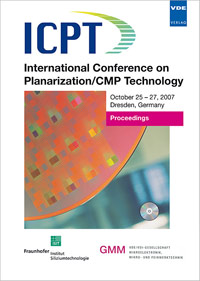Pad Surface Analysis and Conditioning Effects: Implications on Process Design, Break-in Response and Next Generation Pad and Conditioning Platforms
Conference: ICPT 2007 - International Conference on Planarization / CMP Technology
10/25/2007 - 10/27/2007 at Dresden, Germany
Proceedings: ICPT 2007
Pages: 5Language: englishTyp: PDF
Personal VDE Members are entitled to a 10% discount on this title
Authors:
Lawing, Andrew Scott; Juras, Chris (Rohm and Haas Electronic Materials, Phoenix, AZ 85003, USA)
Abstract:
Pad surface analysis is a powerful tool to help understand the impact of pad texture on CMP process performance as well as the implications of pad texture on process and consumable design. Three dimensional pad surface textural data can be interpreted in the form of pad height probability distribution functions, which provide a statistical representation of how the pad surface is distributed in space. The pad height probability distribution function can be deconvolved into three components arising from: 1) the native porosity of the pad material, 2) the surface texturing process applied to the pad material and 3) polishing process effects on the pad near surface. In this paper we will discuss detailed examples of the first two textural components including the characterization of two different pad types and the effects of conditioning on pad materials with differing native porosity and an example of textural evolution with polishing pad break-in.


